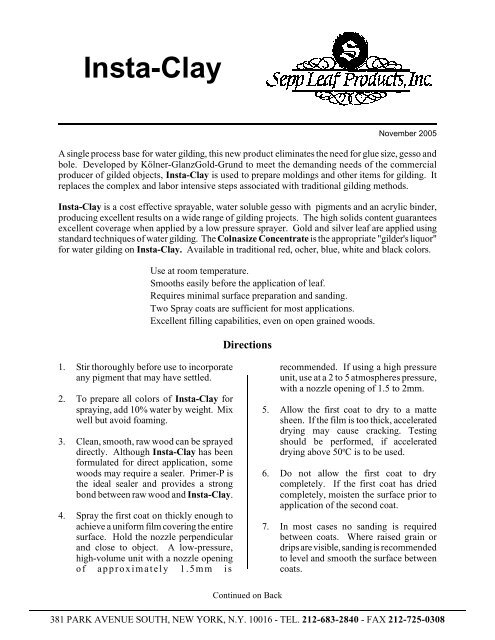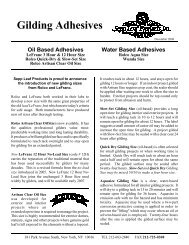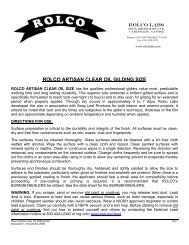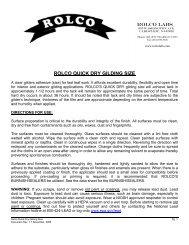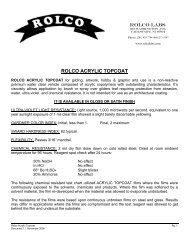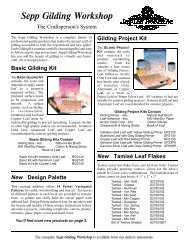Kolner Insta-Clay - Sepp Leaf Products, Inc.
Kolner Insta-Clay - Sepp Leaf Products, Inc.
Kolner Insta-Clay - Sepp Leaf Products, Inc.
You also want an ePaper? Increase the reach of your titles
YUMPU automatically turns print PDFs into web optimized ePapers that Google loves.
<strong>Insta</strong>-<strong>Clay</strong><br />
November 2005<br />
A single process base for water gilding, this new product eliminates the need for glue size, gesso and<br />
bole. Developed by Kölner-GlanzGold-Grund to meet the demanding needs of the commercial<br />
producer of gilded objects, <strong>Insta</strong>-<strong>Clay</strong> is used to prepare moldings and other items for gilding. It<br />
replaces the complex and labor intensive steps associated with traditional gilding methods.<br />
<strong>Insta</strong>-<strong>Clay</strong> is a cost effective sprayable, water soluble gesso with pigments and an acrylic binder,<br />
producing excellent results on a wide range of gilding projects. The high solids content guarantees<br />
excellent coverage when applied by a low pressure sprayer. Gold and silver leaf are applied using<br />
standard techniques of water gilding. The Colnasize Concentrate is the appropriate "gilder's liquor"<br />
for water gilding on <strong>Insta</strong>-<strong>Clay</strong>. Available in traditional red, ocher, blue, white and black colors.<br />
Use at room temperature.<br />
Smooths easily before the application of leaf.<br />
Requires minimal surface preparation and sanding.<br />
Two Spray coats are sufficient for most applications.<br />
Excellent filling capabilities, even on open grained woods.<br />
Directions<br />
1. Stir thoroughly before use to incorporate<br />
any pigment that may have settled.<br />
2. To prepare all colors of <strong>Insta</strong>-<strong>Clay</strong> for<br />
spraying, add 10% water by weight. Mix<br />
well but avoid foaming.<br />
3. Clean, smooth, raw wood can be sprayed<br />
directly. Although <strong>Insta</strong>-<strong>Clay</strong> has been<br />
formulated for direct application, some<br />
woods may require a sealer. Primer-P is<br />
the ideal sealer and provides a strong<br />
bond between raw wood and <strong>Insta</strong>-<strong>Clay</strong>.<br />
4. Spray the first coat on thickly enough to<br />
achieve a uniform film covering the entire<br />
surface. Hold the nozzle perpendicular<br />
and close to object. A low-pressure,<br />
high-volume unit with a nozzle opening<br />
of approximately 1.5mm is<br />
recommended. If using a high pressure<br />
unit, use at a 2 to 5 atmospheres pressure,<br />
with a nozzle opening of 1.5 to 2mm.<br />
5. Allow the first coat to dry to a matte<br />
sheen. If the film is too thick, accelerated<br />
drying may cause cracking. Testing<br />
should be performed, if accelerated<br />
drying above 50 o C is to be used.<br />
6. Do not allow the first coat to dry<br />
completely. If the first coat has dried<br />
completely, moisten the surface prior to<br />
application of the second coat.<br />
7. In most cases no sanding is required<br />
between coats. Where raised grain or<br />
drips are visible, sanding is recommended<br />
to level and smooth the surface between<br />
coats.<br />
Continued on Back<br />
381 PARK AVENUE SOUTH, NEW YORK, N.Y. 10016 - TEL. 212-683-2840 - FAX 212-725-0308
8. Apply the second and final coat while the<br />
first coat is still damp. A uniform spray<br />
film is important. For complex moldings<br />
use a soft saturated brush to smooth out<br />
any sags or runs.<br />
9. The surface can be smoothed using a<br />
Dry, Wet or Alcohol method prior to<br />
gilding.<br />
Dry - Smooth the surface with 400 grit<br />
sandpaper or 0000 steel wool, followed<br />
by a final polishing with a horsehair<br />
cloth.<br />
Wet - Smooth the surface with 400<br />
wet/dry sandpaper using a minimum<br />
amount of water to avoid swelling the<br />
surface. Remove the wet slurry and,<br />
when dry, polish with horsehair cloth.<br />
Alcohol - Rub the surface with a cotton<br />
cloth moistened with ethanol or methanol<br />
(poisonous) until the surface is smooth.<br />
Then rub with a dry cotton cloth. Allow<br />
the alcohol to evaporate for at least one<br />
half hour before proceeding.<br />
Store in closed containers in a cool but frost<br />
free environment. To ensure maximum shelf<br />
life, do not returned unused solutions to the<br />
original container.<br />
<strong>Insta</strong>-<strong>Clay</strong> has undergone extensive development and<br />
testing. It is formulated for use as described above,<br />
and except for the addition of water, should not be<br />
modified in any way. Despite extensive experience and<br />
constant observation of surfaces leafed with <strong>Insta</strong>-<strong>Clay</strong>,<br />
the recommendations herein are non-binding, as the<br />
use and method of application, as well as, the proper<br />
preparation of the surface are beyond our control. The<br />
findings described are based on the results of several<br />
months of experiments under controlled laboratory<br />
conditions.<br />
This instruction sheet includes the latest technical and<br />
research information prepared by Kölner-GlanzGold-<br />
Grund, with support from <strong>Sepp</strong> <strong>Leaf</strong> <strong>Products</strong>. Since<br />
Kölner-GlanzGold-Grund, nor <strong>Sepp</strong> <strong>Leaf</strong> <strong>Products</strong>, can<br />
control the use of this product, the user assumes all<br />
responsibility for the results obtained. Experimentation<br />
on a test object of all steps involved is recommended<br />
before working on the object to be gilded.<br />
10. The standard Colnasize Concentrate<br />
recipe is the recommended "gilder's<br />
liquor" for water gilding an <strong>Insta</strong>-<strong>Clay</strong><br />
surface. Wet the surface very well,<br />
flooding it several times before applying<br />
leaf.<br />
Wait at least two hours, then test a small area<br />
to determine if it is ready for burnishing. Best<br />
results are usually obtained when items are<br />
burnished within 24 hours. If the surface<br />
contains too much moisture, the burnished<br />
area will turn cloudy. If the surface is too dry,<br />
the burnishing may scratch the leaf. In many<br />
cases, burnishing can be accomplished a few<br />
days after gilding.<br />
For further details concerning gilding and<br />
burnishing see the technical data sheet for<br />
Colnasize Concentrate.


